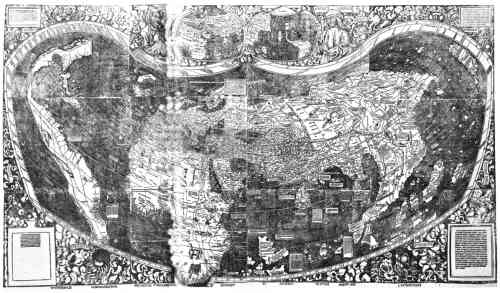| He was an Italian explorer who had the distinction of
recognizing the fact that the lands discovered by Columbus, was not Asia,
but a separate continent. Due to strange circumstances, America was named
after him in 1507, when the German cartographer, Martin
Waldseemüller,
having read about Vespucci's travels to the New World, and not Columbus' printed the
first map using the name Amerigo for the New World. On his first expedition,
he was the navigator for Alonzo
de Ojeda. They left Spain in 1499 and
discovered the mouth of the Amazon and Orinoco River in South America. They
returned to Spain in 1500. On his second expedition to the New World, he
was sailing for Portugal, and left in 1501. He mapped the eastern coast of
the New World, and realize that they were not in Asia, but a totally
different, unknown continent.
|
| In 1503 or 1504, Amerigo published a pamphlet, in
Latin, under the Latinized name of Albericus Vesputius, entitled Mundus
Novus. In this pamphlet, he stated his belief that the land
reached by Columbus, was really a New World. This
was contrary to Columbus continued insistence that he had reached India.
Since Columbus was so firmly entrenched in his belief, he did not give
these lands a collective name (like Columbus). He would give the islands
and regions he saw and or landed on, a name, but he could not rename India
or China. |
In 1507, the Institute at Saint-Dié in
Lorraine, decided to reprint, the Mundus Novus pamphlet
published by Amerigo. They wanted to include a map of the New World, and
name the new publication, Cosmographiae Introductio.
The person chosen to write the preface of this scholarly work, was Martin
Waldseemüller, the new and upcoming geographer, of the Institute. In
Latin, he basically wrote
| "Now, indeed, these
continents (the three "older" continents, Europe, Africa
and Asia) have been broadly explored, and a fourth continent had
been found by Americus Vesputius, as will be shown later. I do not
see why anyone should rightfully object to calling this continent
for Americus (its discoverer, a man of intelligence) to wit, Amerige,
that is, Land of Americus, or America - since both Europe and Asia
got their names from women." |
His proposed name of Amerige is the Italian name, Ameri
with the Greek word for land, ge, for the new
continent. His second suggestion, America is
the Latin Feminine form of Americus, the name used by Amerigo, in
his Mundus Novus, publication. For some unknown reason, when he
published the two maps in 1507, he printed the name America on the map of
South America. Waldseemüller, later changed his mind on Amerigo
Vespucci's credibility, and the name of America was omitted from his later
maps. But by then, it was too late.
Cosmographiae Introductio had a wide circulation, as
well as the map. Within a few years, the name America was widely
established, and even though Waldseemüller later omitted the name
from his maps, America was the name. It is ironic that the man that gave
the name to the land discovered by Columbus, never visited America, and
depended on his knowledge of this land, from the writings of others.
|

